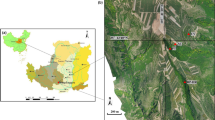Abstract
Separation and chemical characterisation of specific compounds responsible for soil water repellency has not previously been achieved. Here we describe the extraction, separation and analysis by gas chromatography-mass spectrometry of organic compounds found in wettable and water repellent sandy soils from the Netherlands and United Kingdom. Fatty acids (C16–C24), amides (C14–C24), alkanes (C25–C33), aldehydes/ketones (C23–C31) and complex ring-containing structures were detected in all samples. We found a greater abundance of high molecular mass polar compounds in the water repellent samples.


Similar content being viewed by others
References
Bisdom EBA, Dekker LW, Schoute JFT (1993) Water repellency of sieve fractions from sandy soils and relationships with organic material and soil structure. Geoderma 56:105–118
Doerr SH (1998) On standardizing the “water drop penetration time” and the “molarity of an ethanol droplet” techniques to classify soil hydrophobicity: a case study using medium textured soils. Earth Surf Process Landforms 23:663–668
Doerr SH, Shakesby RA, Walsh RPD (2000) Soil water repellency: its causes, characteristics and hydro-geomorphological significance. Earth Sci Rev 51:33–65
Doerr SH, Llewellyn CT, Douglas P, Morley CP, Mainwaring KA, Haskins C, Johnsey L, Ritsema CJ, Stagnitti F, Ferreira AJD, Ziogas AK (in press) Extraction of compounds associated with water repellency in sandy soils of different origin. Aust J Soil Res
Eglinton G, Hamilton RJ, Raphael RA (1962) Hydrocarbon constituents of the wax coating of plant leaves: a taxonomic survey. Nature 193:439–442
Horne DJ, McIntosh JC (2000) Hydrophobic compounds in sands in New Zealand—extraction, characterisation and proposed mechanisms for repellency expression. J Hydrol 231–232:35–46
Hudson RA, Traina SJ, Shane WW (1994) Organic matter comparison of wettable and nonwettable soils from bentgrass sand greens. Soil Sci Soc Amer J 58:361–367
Ma’shum M, Tate ME, Jones GP, Oades JM (1988) Extraction and characterization of water-repellent material from Australian soils. Soil Sci 39:99–110
Roy JL, McGill WB, Rawluk MD (1999) Petroleum residues as water-repellent substances in weathered nonwettable oil-contaminated soils. Can J Soil Sci 79:367–380
Acknowledgements
The financial assistance of EPSRC, Aquatrols Corporation of America, HEFCW and the University of Wales Swansea for providing a studentship (KAM) and a postgraduate bursary (CTL) is acknowledged. This study was supported by EU grant FAIR-CT98–4027. This work does not necessarily reflect the European Commission’s views and in no way anticipates its future policy in this area.
Author information
Authors and Affiliations
Corresponding author
Rights and permissions
About this article
Cite this article
Mainwaring, K.A., Morley, C.P., Doerr, S.H. et al. Role of heavy polar organic compounds for water repellency of sandy soils. Environ Chem Lett 2, 35–39 (2004). https://doi.org/10.1007/s10311-004-0064-9
Received:
Accepted:
Published:
Issue Date:
DOI: https://doi.org/10.1007/s10311-004-0064-9




